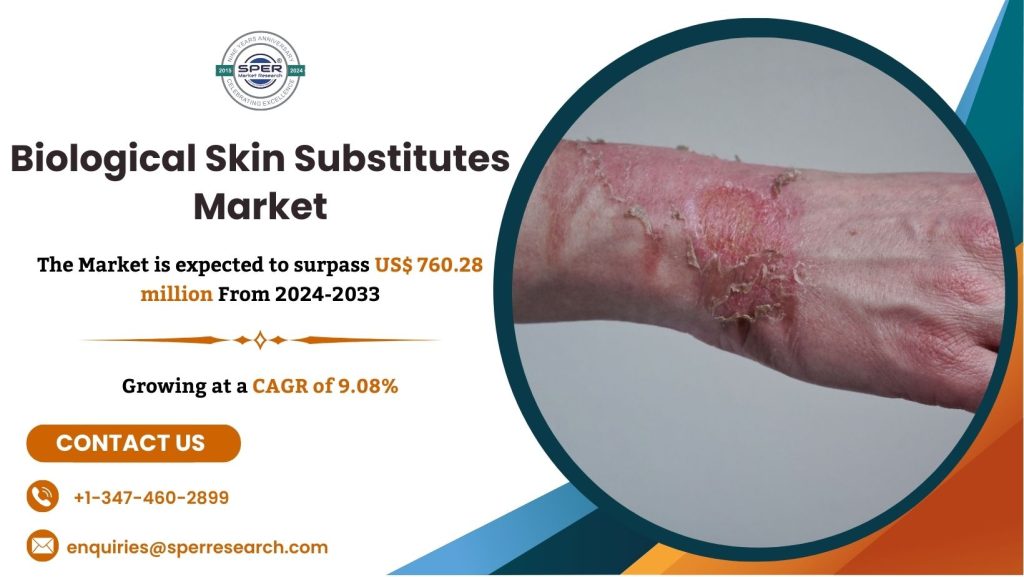Biologic and Synthetic Skin Substitutes Market Share, Rising Trends, Revenue Growth, Challenges, Opportunities and Forecast Analysis till 2033: SPER Market Research

Biologic and Synthetic Skin Substitutes Market
The use of biological skin replacements is essential in tissue engineering and wound care. Collagen or cultivated skin cells are examples of natural, biocompatible materials used to create these lab-grown substitutes. These alternatives help heal serious skin injuries including burns, ulcers, and surgical wounds because they are made to closely resemble the composition and functionality of normal human skin. In addition to provide instant relief by covering the exposed wound, biological skin substitutes encourage the skin’s natural healing process. When more conventional methods, such as skin transplants from the patient or donors, are not practical, they are frequently employed.
According to SPER market research, ‘Global Biological Skin Substitutes Market Size- By Type, By Application, By End-Use – Regional Outlook, Competitive Strategies and Segment Forecast to 2033’ state that the Global Biological Skin Substitutes Market is predicted to reach 760.28 million by 2033 with a CAGR of 9.08%.
Drivers: The increasing prevalence of chronic wounds, burns, and skin-related illnesses is driving the market expansion. The rising prevalence of chronic wounds, burns, and skin-related ailments is driving market expansion for biological skin substitutes, indicating an increasing demand for enhanced wound care solutions. The rising prevalence of chronic disorders such as diabetes, vascular diseases, and pressure ulcers has resulted in an increasing patient population with non-healing wounds, necessitating effective and innovative wound treatment strategies. Biological skin substitutes are a viable alternative because they solve the issues associated with chronic wounds, promote quick healing, and reduce the risk of consequences.
Restraints: The pricey nature of biological skin substitutes is one of the main obstacles to their widespread use. It takes complex, expensive manufacturing procedures, such as the collection, processing, and preservation of tissues obtained from humans or animals, to create biological skin substitutes. Therefore, biological skin substitutes are not widely available due to their high cost, which limits their ability to improve wound care and skin regeneration outcomes for people worldwide.
Request For Free Sample Report @ https://www.sperresearch.com/report-store/biological-skin-substitutes-market.aspx?sample=1
Impact of COVID-19 on Global Biological Skin Substitutes Market
The market for biological skin substitutes was negatively impacted by the COVID-19 pandemic, mainly because of supply chain interruptions, decreased demand for non-urgent medical treatments, resource reallocation, financial strain on the healthcare system, and market uncertainty. All of these issues combined to cause a decline in the use of biological skin substitutes and a postponement of burn and chronic wound treatments. Thus, the market for biological skin substitutes was severely hampered in its growth and operational dynamics by the pandemic.
Global Biological Skin Substitutes Market Key Players:
The North American biological skin substitute industry dominated the global market in 2024. The increased frequency of chronic wounds and burn injuries, as well as the increasing demand for Advanced Wound Care (AWC) solutions, are driving regional market expansion. Some significant market players are Organogenesis, Inc, 3M, Integra LifeSciences, Smith and Nephew, Tissue Regenix, Mimedx, and others.
For More Information, refer to below link:-
Biological Skin Substitutes Market Size
Related Reports:
Follow Us –
LinkedIn | Instagram | Facebook | Twitter
Contact Us:
Sara Lopes, Business Consultant – U.S.A.
SPER Market Research
+1-347-460-2899





